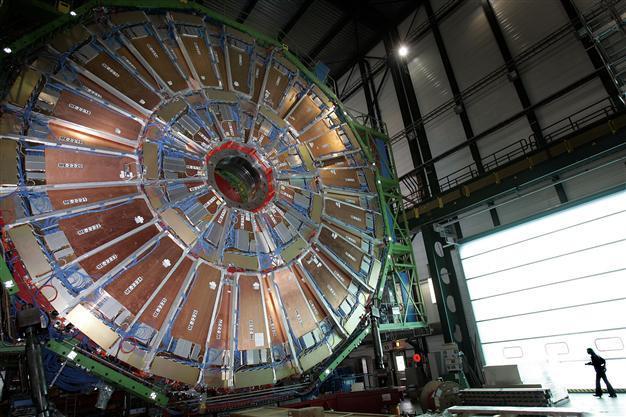Eureka! Physicists celebrate evidence of particle
GENEVA - The Associated Press

If physicists can confirm the existence of the Higgs boson, the last missing piece in the standard model of physics, the announcement would rank among the most important scientific breakthroughs of the last century. AFP Photo
To cheers and standing ovations, scientists at the world’s biggest atom smasher claimed the discovery of a new subatomic particle Wednesday, calling it "consistent" with the long-sought Higgs boson - popularly known as the "God particle" - that helps explain what gives all matter in the universe size and shape."We have now found the missing cornerstone of particle physics," Rolf Heuer, director of the European Center for Nuclear Research (CERN), told scientists.
He said the newly discovered subatomic particle is a boson, but he stopped just shy of claiming outright that it is the Higgs boson itself - an extremely fine distinction.
"As a layman, I think we did it," he told the elated crowd. "We have a discovery. We have observed a new particle that is consistent with a Higgs boson."
The Higgs boson, which until now has been a theoretical particle, is seen as the key to understanding why matter has mass, which combines with gravity to give an object weight. The idea is much like gravity and Isaac Newton’s discovery of it: Gravity was there all the time before Newton explained it. But now scientists have seen something very much like the Higgs boson and can put that knowledge to further use.
CERN’s atom smasher, the $10 billion Large Hadron Collider on the Swiss-French border, has been creating high-energy collisions of protons to investigate dark matter, antimatter and the creation of the universe, which many theorize occurred in a massive explosion known as the Big Bang.
Two independent teams at CERN said Wednesday they have both "observed" a new subatomic particle - a boson. Heuer called it "most probably a Higgs boson, but we have to find out what kind of Higgs boson it is. "
Asked whether the find is a discovery, Heuer answered, "As a layman, I think we have it. But as a scientist, I have to say, "’What do we have?’ "
The leaders of the two CERN teams - Joe Incandela, head of CMS with 2,100 scientists, and Fabiola Gianotti, head of ATLAS with 3,000 scientists - each presented in complicated scientific terms what was essentially extremely strong evidence of a new particle.
Incandela said it was too soon to say definitively whether it is the "standard model" Higgs that Scottish physicist Peter Higgs and others predicted in the 1960s - part of a standard model theory of physics involving an energy field where particles interact with a key particle, the Higgs boson.
"The" Higgs or "a” Higgs - that was the question Wednesday.
"It is consistent with a Higgs boson as is needed for the standard model," Heuer said. "We can only call it a Higgs boson - not the Higgs boson."
Higgs, who was invited to be in the audience, said he also could not yet say if it was part of the standard model. But he told the audience the discovery appears to be very close to what he predicted.
"It is an incredible thing that it has happened in my lifetime," he said, calling it a huge achievement for the proton-smashing collider built in a 27-kilometer (17-mile) underground tunnel.
The stunning work elicited standing ovations and frequent applause at a packed auditorium in CERN as Gianotti and Incandela each took their turn.
Incandela called it "a Higgs-like particle" and said "we know it must be a boson and it’s the heaviest boson ever found."
"Thanks, nature!" Gianotti said to laughs, giving thanks for the discovery.
Later, she told reporters that "the standard model (of physics) is not complete" but that "the dream is to find an ultimate theory that explains everything - we are far from that."
The phrase "God particle" was coined by Nobel Prize-winning physicist Leon Lederman but is used by laymen, not physicists, as an easier way of explaining how the subatomic universe works and got started.
Incandela said the last undiscovered piece of the standard model could be a variant of the Higgs that was predicted or something else that entirely changes the way scientists think about how matter is formed.
"This boson is a very profound thing we have found," he said. "We’re reaching into the fabric of the universe in a way we never have done before. We’ve kind of completed one particle’s story ... now, we’re way out on the edge of exploration."
Factfile on Higgs boson
Agence France-Presse
Following is a factfile on the Higgs boson:
WHAT IS IT?
The Higgs boson is conceived as a sub-atomic particle that confers substance.
It is conceived as existing in a treacly, invisible field that was created after the "Big Bang" and pervades the Universe. Higgs bosons "stick" to fundamental particles of matter, dragging on them, and then decay themselves into another form.
Some of these particles interact more with the Higgs than others and thus have greater mass, according to the theory. But particles of light, also called photons, are impervious to it and have no mass.
WHY IS IT IMPORTANT?
The origin of mass -- meaning the resistance of an object to being moved -- has been fiercely debated for decades.
Finding the Higgs boson would vindicate the so-called Standard Model of physics, a theory that developed in the early 1970s, which says the Universe is made from 12 particles which provide the building blocks for all matter.
These fundamental particles are divided into a bestiary comprising six leptons and six quarks, which have exotic names such as "strange," "up", "tau" and "charm."
WHY IS IT CALLED THE HIGGS BOSON?
The name comes from a British physicist, Peter Higgs, today aged 83, who conceived of a field of mass-conferring particles in 1964 and became the first to publish his idea.
Important theoretical work was also done separately by Belgian physicists Robert Brout, who died in 2011, and Francois Englert, 79.
Bosons are non-matter particles which are force carriers, or messengers that act between matter particles.
The interaction gives rise to three fundamental forces -- the strong force, the weak force and the electromagnatic force. There is a fourth force, gravity, which is suspected to be caused by a still-to-be found boson named the graviton.
HOW HAS THE HIGGS BEEN HUNTED?
The quest for the Higgs has been carried out at colliders: giant machines that smash particles together and sift through the sub-atomic debris that tumbles out.
The big daddy of these is the Large Hadron Collider (LHC), operated by the European Organisation for Nuclear Research (CERN) in a ring-shaped tunnel deep underground near Geneva.
Smashups generated at the LHC briefly generate temperatures 100,000 times hotter than the Sun, replicating the conditions that occurred just after the Universe's creation in the "Big Bang" nearly 14 billion years ago.
But these concentrations of energy, while violent, occur only at a tiny scale.
On Wednesday, CERN scientists said they had found a new particle that was "consistent" with the Higgs, but further work was needed to determine what it was.
WHY "THE GOD PARTICLE"?
The Higgs has become known as the "God particle," the quip being that, like God, it is extremely powerful, exists everywhere but is hard to find.
In fact, the origin of the name is rather less poetic.
It comes from the title of a book by Nobel physicist Leon Lederman whose draft title was "The Goddamn Particle," to describe the frustrations of trying to nail the Higgs.
The title was cut back to "The God Particle" by his publisher, apparently fearful that "Goddamn" could be offensive.
















